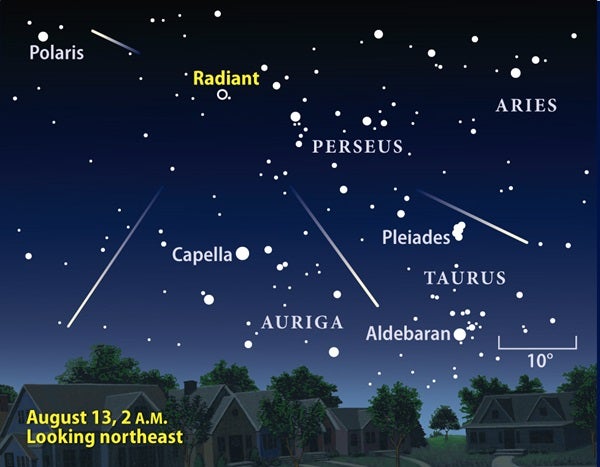The Perseids have that name because if you traced all the meteor trails backward, they would meet within the boundaries of the constellation Perseus, the hero who, according to Greek mythology, slew the Gorgon Medusa.
The Perseids’ peak occurs after midnight August 12. New Moon occurred around 11 p.m. August 9, so the thin crescent will set just a few hours after sunset on the 12th.
We see Perseid meteors because the shower’s parent comet, 109P/Swift-Tuttle, has ejected dust grains along its path during numerous trips through the solar system. Each year around this time, Earth passes through the debris stream, and we experience a meteor shower.
Perseid meteors are fast — their speeds top 125,000 mph (200,000 km/h) — and many leave smoke trails that can last several seconds. Many Perseids are also bright and usually appear white or bluish-white.
August 12 and 13 aren’t the only dates you can observe Perseids. This year, the shower’s activity started around July 17, and it will continue through August 24. Of course, you’ll see fewer meteors the farther you observe from the peak date.
A clear, dark sky will help you maximize your meteor count. “Dark” means at least 40 miles from the lights of a large city. You won’t need a telescope — in fact, using your eyes alone will work best because they provide the widest field of view.
Early in the evening on Thursday, August 12, set up a lawn chair, preferably one that reclines. Face east and look halfway up. After midnight, adjust your chair, and generally look overhead. Glancing around won’t hurt anything.
In addition to your chair, bring a blanket, bug spray, a snack, and a non-alcoholic beverage if you’d like something to drink. Alcohol interferes with how well your eyes adapt to the darkness as well as the visual perception of events.
How many Perseids will you see? This year, you can expect 60 meteors per hour from a dark site, and your count may top 100 per hour.
- Video: How to observe meteor showers
- StarDome: Locate the Perseid meteor shower’s radiant in your night sky with our interactive star chart.
- Sign up for our free weekly e-mail newsletter.










